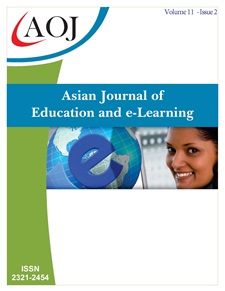Proposal for the Possibility of Teaching Programming in the Subject of Computer Science using Autodesk Tinkercad
DOI:
https://doi.org/10.24203/ajeel.v11i2.7187Keywords:
Arduino, Programing, Education, Primary school, TinkercadAbstract
In today's world, we are witnessing a rapid boom in the implementation of various elements of robotics, intelligent, learning and other systems in our daily lives. The emphasis is on a multidisciplinary approach. These systems build on both hardware and software. Therefore, the question of programming is topical and we meet processors at every step. Our goal is to show within a few lessons the possibility of learning the principles of processor programming in a simple way, without the need for deeper knowledge of electronics or hardware. The use of the Arduino platform appears to be advantageous in this regard. It provides enough power and flexibility for educational purposes, while the Arduino IDE development environment is simple enough. Due to its diversity in terms of robustness and performance, Arduino is also widely used in practice, usually as an extension of existing systems. As an example, we can mention e.g. unmanned UAVs, camera or security systems, control and signaling systems, etc. Therefore, we see the sense of dealing with Arduino in education as well.
References
[]Arduino. (15. 10 2022). What is Arduino? Dostupné na Internete: Arduino.cc: https://www.arduino.cc/en/Guide/Introduction
CZAKÓOVÁ, K. 2021. Game-based programming in primary school informatics. In: INTED2021 Proceedings. IATED, 2021. p. 5627-5632.
Mocsi Gergő, M. (2020). Design of a drone for meteorological data collection. Komárno: J. Selye University. Bakalárska práca. školiteľ: Ing. Ondrej Takáč, PhD.
Stoffová, V., Takáč, O. (2013). ROBOTICKÉ STAVEBNICE V PRÍPRAVE UČITEĽOV INFORMAČNEJ VÝCHOVY. Trendy ve vzdělávání, 6(1), 315-322.
pkareeyah. (2020). Arduino DC Motor. Tinkercad: https://www.tinkercad.com/things/ 0RfmRZS79EE-arduino-dc-motor
Takáč, O., Hrubý, D., & Cviklovič, V. (2011). POSSIBILITIES OF NAVIGATION OF MOBILE AGRICULTURAL ROBOTS ON THE PRINCIPLE OF THE GEOMETRICAL OBJETS DETECTIONS. MANAGEMENT ECONOMIC ENGINEERING IN AGRICULTURE AND RURAL DEVELOPMENT, 11(1), 206-208p. Volume: 11 Issue: 1. ISSN: 2284-7995. WoS :000422170400044
Takáč, O., Tomášik, L., Hrubý, D., & Palková, Z. (2012). EXACT NAVIGATION OF SMALL AGRICULTURAL MOBILE ROBOTS WITH THE UTILIZATION OF LASER RAY. MANAGEMENT ECONOMIC ENGINEERING IN AGRICULTURE AND RURAL DEVELOPMENT, 12(1), 239-241p. Volume: 12 Issue: 1. ISSN: 2284-7995. WoS :000422176100048
Takáč, O., Végh, L. (2021) USAGE OF UAVS IN THE PROTECTION OF CULTURAL HERITAGE IN THE TEACHING OF COMPUTER SCIENCE. In: INTED2021 Proceedings. IATED, 2021. p. 9987-9992.
Tusor, B., Takáč, O., Molnár, A., Gubo, Š., & Várkonyi Kóczi, A. (2020). Shape Recognition in Drone Images Using Simplified Fuzzy Indexing Tables. 2020 IEEE 18TH WORLD SYMPOSIUM ON APPLIED MACHINE INTELLIGENCE AND INFORMATICS (SAMI 2020) (s. 129-134). Herľany: SAMI 2020. ISBN: 978-1-7281-3149-8. WoS :000589772600025
Udvaros, J., Takáč, O. (2020) Developing Computational Thinking By Microcontrollers. In: ICERI2020 Proceedings. IATED, 2020. p. 6877-6882.
Végh, L., Takáč, O. (2021) Online Games to Introducing Computer Programming to Children. In: INTED2021 Proceedings. IATED, 2021. p. 10007-10015.
Downloads
Published
Issue
Section
License
Copyright (c) 2023 Ondrej Takáč, Robert Kanta, Andrea Takáčová

This work is licensed under a Creative Commons Attribution-NonCommercial 4.0 International License.
- Papers must be submitted on the understanding that they have not been published elsewhere (except in the form of an abstract or as part of a published lecture, review, or thesis) and are not currently under consideration by another journal published by any other publisher.
- It is also the authors responsibility to ensure that the articles emanating from a particular source are submitted with the necessary approval.
- The authors warrant that the paper is original and that he/she is the author of the paper, except for material that is clearly identified as to its original source, with permission notices from the copyright owners where required.
- The authors ensure that all the references carefully and they are accurate in the text as well as in the list of references (and vice versa).
- Authors retain copyright and grant the journal right of first publication with the work simultaneously licensed under a Attribution-NonCommercial 4.0 International that allows others to share the work with an acknowledgement of the work's authorship and initial publication in this journal.
- Authors are able to enter into separate, additional contractual arrangements for the non-exclusive distribution of the journal's published version of the work (e.g., post it to an institutional repository or publish it in a book), with an acknowledgement of its initial publication in this journal.
- Authors are permitted and encouraged to post their work online (e.g., in institutional repositories or on their website) prior to and during the submission process, as it can lead to productive exchanges, as well as earlier and greater citation of published work (See The Effect of Open Access).
- The journal/publisher is not responsible for subsequent uses of the work. It is the author's responsibility to bring an infringement action if so desired by the author.


